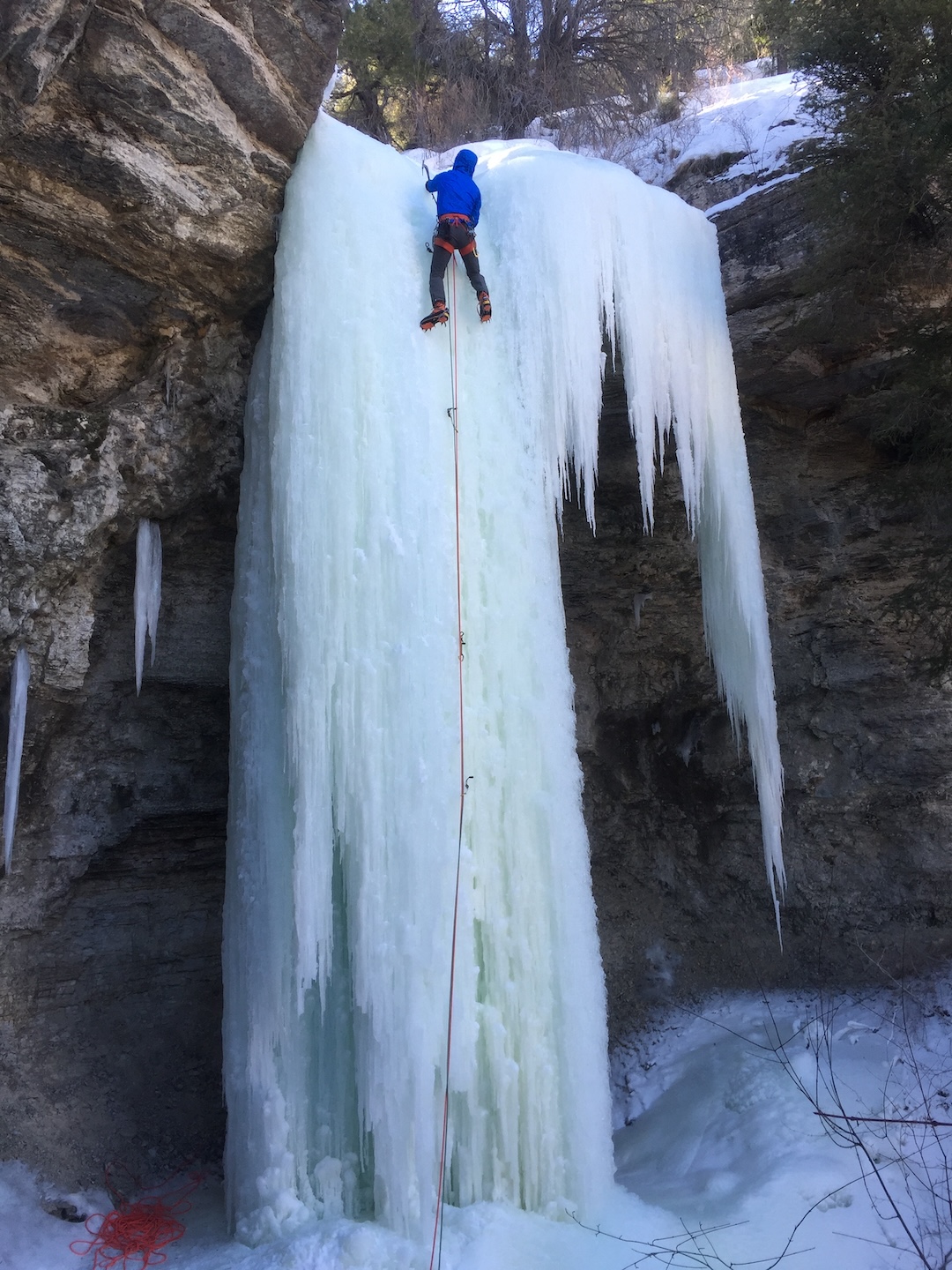Fall on Ice — Collapsed Ice Pillar
Utah, Duchesne Area, Right Fork of Indian Canyon

On April 2, Meg O’Neill (40), a member of a party of three climbers, was killed when struck by a collapsing ice column on Raven Falls (WI4), near Duchesne in northeast Utah. According to the Duchesne County Sheriff’s Office, O’Neill saved the belayer’s life by pushing the latter out of the fall zone. The leader was seriously injured.
Sean McLane (34) was on lead near the top of the second pitch when the accident occurred. He was belayed by Anne Nikolov (21) while O’Neill was spectating. McLane wrote to ANAC:
“It had been warm for a couple of days, and this was to be my last climb of the season. We were a group of three. Meg was experienced and a regular climbing partner of mine. Anne was new and had climbed a couple of times with Meg.” McLane led the first pitch and brought the other two up.
“The second pitch was an ice column that formed at the lip of a cave. It was 40 feet high, 60 feet wide, and 15 feet in diameter. I saw no signs of instability. I didn’t see or hear any significant running water. There was little to no cone at the bottom, although a 15-foot radius of ice was present on the ground at the base. I stomped on it to test for anything being undercut, but it felt solid, likely because it was a couple feet thick and my weight wasn’t enough to stress it.
“I led out the back of the ice and corkscrewed around to the side. Anne [Nikolov] was belaying, and Meg [O’Neill] was walking around, taking pictures. As I was nearly topping out, there was a significant density change in the ice. It went from wet, one-swing sticks to dense, dinner-plating hits.”
McLane climbed above the point where the ice was attached to the rock. As he swung an ice tool into an already dinner-plated placement, the pillar fractured, breaking two or three feet below the point of the pick’s impact.
According to McLane, the collapse took “my other tool and both my feet with it. Meg was in the cave behind the pillar, and Anne was to the side. Most of the column went downhill, but falling ice buried Meg.”
Climbing magazine wrote that O’Neill “noticed the ice fracture, and…may have heard it cracking just before the formation broke.” She then pushed Nikolov aside. Climbing further wrote, “Her quick thinking undoubtedly saved Anne’s life.”
McLane fell when the pillar collapsed. He recalls, “I had placed screws in the pillar and was pulled off by the rope. The main column fell down the slope away from me, and I came straight down. I hit the ground, landing on my back atop a large chunk of ice. This broke my spine at L2. That was my only injury besides scrapes and bruises.
“I put myself in recovery position as Anne tried to get to Meg. Eventually, I had to decide to send Anne down for help. No 911 calls would go through, and the closest cell service was driving distance away. I showed Anne how to fix a rappel line [to descend the first pitch]. I then gave her my phone and told her where to find my car keys. I took her light puffy to lie on. (I was only wearing a base layer and a hard shell.) Anne drove to town and contacted SAR and local ice climbers. About six hours after the collapse, some Salt Lake climbing friends got up to me. They moved me to where I could be long-lined off. The helicopter brought me to the road, where I was loaded into another helicopter and taken to the hospital in Salt Lake.” McLane has physically recovered, and he returned to climbing after about six months.
ANALYSIS
Ice climbing is perhaps one of the most dangerous of climbing games. As described above, frozen water is a fickle, ever-changing medium, and the hazards are often invisible. On Raven Falls, McLane—a very experienced climber who had safely climbed the route twice previously—visually assessed the ice and stomp-tested the base to ensure the column was attached. He wrote to ANAC that, “in retrospect, to fail as it did, the pillar must have been melted out from underneath.” The solid-looking column was “basically a free-hanging, bus-sized chunk of ice.”
McLane notes:
• Running water underneath an ice formation can turn a solid and fully attached flow free-hanging and unstable. Figuring out if ice is undercut can be hard to impossible to do without seeing the running water or the gap between the bottom of the pillar and the base. Several days of warmer temperatures can create this dangerous situation.
• Large variations in ice quality and density on the route may signal stability issues.
• Create a large margin when positioning oneself at the base of an ice route in order to stay out of the way of falling ice. A cave is not necessarily protected if the ice collapses.
• Carry an extra layer. Since it was a warm day, I left my puffy at the base a pitch below. I got very cold lying on ice and not moving for many hours.
• Carry a rescue communicator (inReach) on your person—don’t leave it at the base of a multi-pitch route. I now carry one on my harness or backpack strap. (We didn’t have one on that day, but it would have been at the base if we had.) (Sources: Climbing magazine, Sean McLane, and the Editors.)

